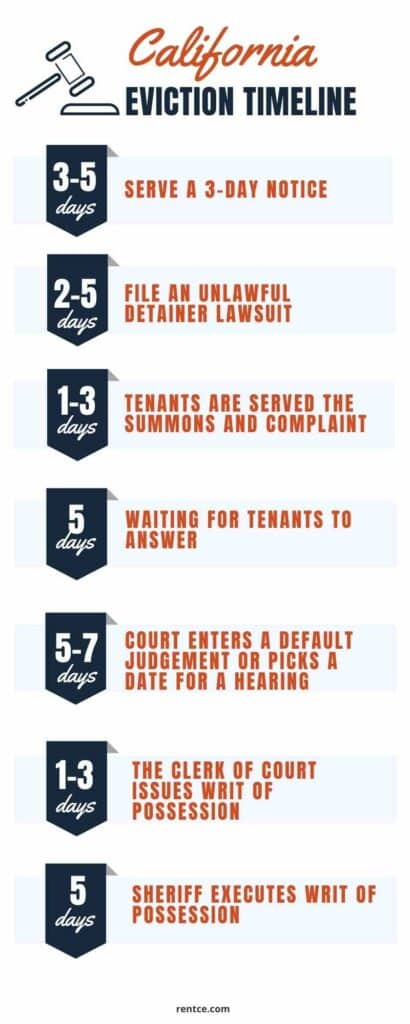Eviction cases, called “unlawful detainer”, move fast through the courts. It can take from 20 to 45 days on average to evict a tenant for failure to pay rent.

These are the main steps in the eviction process:
Step 1:
Serve the appropriate notice based on the reason you want to evict the tenant. For failure to pay rent, serve a 3-Day Notice.
Step 2:
Wait 3 business days for the tenant to make payment.
Step 3:
File an unlawful detainer lawsuit if the tenant failed to pay.
Step 4:
The tenant has five days in most cases to respond to the lawsuit.
Step 5:
If the tenant responds, a court hearing is scheduled usually within 20 Days
If the tenant doesn’t respond the landlord wins the case.
Step 6:
The court issues a writ of possession if the landlord wins the case.
Step 7: If the tenant doesn’t leave within five days from the date that the writ is served, the Sheriff is authorized to physically remove the tenant.
The 3-Day Notice
To properly terminate a tenant for non-payment of rent, you must first fill out and deliver a form called a three-day notice to pay or quit. The tenant then has three days to make payment. If they do make payment, then this notice ends.
However, if the tenant stays beyond the three days and fails to pay, you may then go ahead and file an unlawful detainer lawsuit. Tenants have to have full three business days to pay, the day the notice is delivered doesn’t count and the notice cannot end on a Saturday or a Sunday, or a Holiday.
If the tenant offers to pay the rent after the expiration of the three-day notice, you do not have to accept the rent payment. However, if you do accept the rent payment, you can not continue with your eviction lawsuit. This also applies to accepting partial payments. If you accept a partial payment, you have to serve the notice again with the updated amount.
What must go into the three-day notice to pay or quit?
Obviously, it must have the tenants’ names and the description of the property, the street address, the city, the county, and the state. It must have the exact amount due and the due date and a statement that you will pursue legal action.
If the tenant does not pay it also must advise the tenant that the lease will be forfeited. It must have information on to whom where, and how the rent has to be paid. Finally, a signature by yourself or your manager or other person authorizing the three-day notice.
Fees you should not include in your notice: late charges, check bounce fees, or any kind of interest utility charges, or anything else that’s not rent.
That doesn’t mean you cannot legally collect these fees. You can collect them from the security deposit or
One thing to know is that if you are in an area that has rent control ordinances, there are special provisions that must be added to this notice to pay rent or quit. Contact an attorney to get assistance if your property is in such an area:
Berkeley
Beverly Hills
Campbell
East Palo Alto
Fremont
Hayward
Los Angeles
Los Gatos
Oakland
Palm Springs
San Francisco
San Jose
Santa Monica
Thousand Oaks
West Hollywood
Delivering the 3-Day Notice
Make sure to deliver the 3-Day Notice properly in order to be legal. Here are the three ways you can serve the notice:
- By personal service – the landlord, the landlord’s agent, or anyone over 18 can serve a notice on a tenant.
- By substituted service – If the landlord can’t find the tenant at home, he can try to serve the notice at work. If the notice can’t be served personally, it can be left with a person of “suitable age. If substituted service is used, the notice also needs to be mailed. The three days period starts after both steps have been completed.
By posting and mailing – If personal or substituted service can’t be done, then the landlord can tape a copy of the notice on the front door or another conspicuous place and also mail the notice. The service of the notice is not complete until the notice has been mailed. The three-day period begins the day after the notice was both posted and mailed.
What can delay the eviction?
There are things that are beyond the control of the landlord or the property manager that can delay the eviction. For example, if the tenant avoids the process server, the landlord may have to petition the court to serve the summons and complaint by posting and mailing them. This can delay the eviction by 30 days.
Another delay can be if the tenant declares bankruptcy before a judgment is entered. The landlord can ask the court to lift the automatic stay and complete the eviction.
Resources:
Superior Court of CA Contra Costa County – Landlord / Tenant (Unlawful Detainer)
Code of Civil Procedure Section 1167.3
Code of Civil Procedure Section 1170.5(a)

